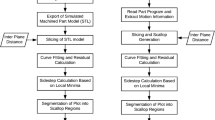Abstract
An algorithm for three-axis NC tool path generation on sculptured surfaces is presented. Non-constant parameter tool contact curves are defined on the part by intersecting parallel planes with the part model surface. Four essential elements of this algorithm are introduced: initial chordal approximation, true machining error calculation, direct gouge elimination, and non-constant parameter tool pass interval adjustment. A software implementation of this algorithm produces graphical output depicting the tool path superimposed over the part surface, and it outputs cutter location (CL) data for further post-processing. Several applications examples are presented to demonstrate the capabilities of the algorithm. The results of this technique are compared to those generated from a commercially available computer-aided manufacturing program, and indicate that equivalent accuracy is obtained with many fewer CL points.
Similar content being viewed by others
Abbreviations
- C :
-
cutting curve
- C 1 :
-
cutting curve tangent
- CC 0,CC 1, ...:
-
cutter contact points
- d :
-
chordal deviation
- /_ABC :
-
triangle
- Δw :
-
incremental step in parameterw
- 〈ABC :
-
angle
- ε:
-
a small quantity
- l :
-
chord length
- n s ,n p , ...:
-
normal vectors
- P, P r ,P c ,P 1 ,P 2 , ...:
-
space point
- Q :
-
parametric equation of a surface
- R :
-
radius of a ball-end milling tool
- TC 0,TC 1, ...:
-
tool center points
- u, v, u s ,u c ,w, t :
-
parameters
- ϕ:
-
angle
- ρ:
-
curvature
- h :
-
cusp height
- T :
-
machining tolerance
References
C.-H. Chang and M. A. Melkanoff,NC Machine Programming and Software Design, Prentice-Hall, New Jersey, 1989.
M. P. Groover,Automation, Production Systems, and Computer-Integrated Manufacturing, Prentice-Hall, New Jersey, 1987.
G. C. Loney and T. M. Ozsoy, “NC machining of free form surfaces”,Computer-Aided Design,19(2), pp. 85–90, March 1987.
B. K. Choi, C. S. Lee, J. S. Hwang and C. S. Jun, “Compound surface modelling and machining”,Computer-Aided Design,20(3), pp. 127–136, April 1989.
D. A. Wysocki, J. H. Oliver and E. D. Goodman, “Gouge detection algorithms for sculptured surface NC generation”,ASME Computer-Aided Design and Manufacture of Cutting and Forming Tools, PED40, pp. 39–44, 1989.
M. E. Mortenson,Geometric Modeling, John Wiley & Sons Inc., New York, 1987.
J. E. Bobrow, “NC machine tool path generation from CSG part representations”,Computer-Aided Design,17(2), pp. 69–76, 1985.
J. Pegna and F.-E. Wolter, “Designing and mapping trimming curves on surfaces using orthogonal projection”,ASME Advances in Design Automation, Vol. 1, Computer Aided and Computational Design, DE-Vol. 23-1, pp. 235–245, September 1990.
R. L. Fox,Optimization Methods for Engineering Design, Addison-Wesley Publishing Company, New York, 1971.
B. K. Choi and C. S. Jun, “Ball-end cutter interference avoidance in NC machining of sculptured surfaces”,Computer-Aided Design,21(6), pp. 371–378, July/August, 1989.
Y. S. Suh and K. Lee, “NC milling tool path generation for arbitrary pockets defined by sculptured surfaces”,Computer-Aided Design,22(5), pp. 371–378, June 1990.
Author information
Authors and Affiliations
Rights and permissions
About this article
Cite this article
Huang, Y., Oliver, J.H. Non-constant parameter NC tool path generation on sculptured surfaces. Int J Adv Manuf Technol 9, 281–290 (1994). https://doi.org/10.1007/BF01781282
Issue Date:
DOI: https://doi.org/10.1007/BF01781282




